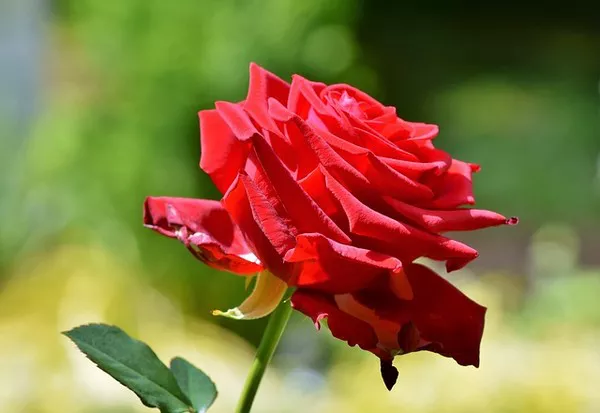Flowers have long captivated humanity with their beauty, fragrance, and symbolism. Among the vast array of floral wonders that adorn gardens and landscapes worldwide, one stands out as a perennial favorite: the rose. With its exquisite blooms and rich cultural significance, the rose holds a special place in the hearts of people around the globe. In this article, we delve into the allure of the rose, exploring its history, symbolism, varieties, and enduring popularity.
A Brief History of the Rose
The history of the rose dates back thousands of years, with evidence of its cultivation found in ancient civilizations such as those of China, Egypt, and Mesopotamia. In these early cultures, the rose held deep symbolic meaning, often associated with love, beauty, and spirituality.
Ancient Greek and Roman societies revered the rose as a symbol of love and beauty, with the goddesses Aphrodite and Venus frequently depicted adorned with roses. The Romans used roses extensively in rituals and celebrations, and rose petals were scattered at feasts and banquets as a sign of luxury and opulence.
During the Middle Ages, the rose continued to be highly prized, becoming a symbol of the Virgin Mary in Christian iconography. Monks cultivated roses in monastery gardens, where they were used for medicinal purposes as well as for spiritual contemplation.
In the 17th and 18th centuries, rose cultivation flourished in Europe, particularly in England and France. The rose became a symbol of aristocratic power and privilege, adorning the gardens of kings and nobles with its sumptuous blooms.
Symbolism of the Rose
The rose’s symbolism is as rich and varied as its many hues and varieties. Across cultures and throughout history, the rose has been imbued with diverse meanings, ranging from love and passion to purity and renewal.
One of the most enduring associations of the rose is with love and romance. The red rose, in particular, has become synonymous with passionate love and desire, making it a quintessential symbol of Valentine’s Day and romantic gestures worldwide. In literature, art, and music, the rose often serves as a metaphor for the complexities of love and the fleeting nature of beauty.
Beyond its association with romantic love, the rose also carries symbolic significance in other contexts. In Christianity, the rose is a symbol of the Virgin Mary and the mystical rose garden of paradise. In Hinduism and Buddhism, the rose represents spiritual enlightenment and the unfolding of the soul.
In addition to its symbolic associations, the rose holds practical significance in various cultural practices and traditions. Rose water, extracted from the petals of the flower, has been used for centuries in perfumes, cosmetics, and culinary delights. Rose oil, valued for its fragrance and therapeutic properties, is used in aromatherapy and holistic healing practices.
Varieties of Roses
The rose genus, Rosa, encompasses a vast array of species and cultivars, each with its own unique characteristics and beauty. From the classic hybrid tea roses to the wild and rambling old garden roses, there is a rose variety to suit every taste and preference.
Hybrid tea roses, with their elegant form and long stems, are perhaps the most iconic of all rose varieties. Bred for their repeat flowering and diverse color range, hybrid teas are a favorite choice for cut flowers and garden displays.
Grandiflora roses combine the best traits of hybrid teas and floribundas, producing large, showy blooms on vigorous, upright plants. With their striking colors and prolific flowering habit, grandifloras are prized for their garden performance and versatility.
Floribunda roses, characterized by their clusters of blooms on compact, bushy plants, are popular for their abundant flowering and ease of care. These charming roses come in a wide range of colors and are ideal for mass plantings, borders, and container gardening.
Climbing roses add vertical interest to gardens and landscapes, with their long, arching canes and profusion of blooms. Whether trained on trellises, arbors, or walls, climbing roses create a stunning focal point and provide a romantic backdrop for outdoor spaces.
Old garden roses, also known as heirloom or heritage roses, encompass a diverse group of species and cultivars that have been cultivated for centuries. These roses are prized for their historical significance, fragrance, and charm, evoking the beauty and nostalgia of bygone eras.
The Enduring Popularity of the Rose
Despite the ever-changing trends in gardening and floral design, the rose remains a timeless favorite among gardeners, florists, and enthusiasts alike. Its enduring popularity can be attributed to a combination of factors, including its beauty, fragrance, versatility, and rich symbolism.
The rose’s unparalleled beauty captivates the senses with its exquisite form, velvety petals, and enchanting fragrance. Whether displayed in a vase, adorning a wedding bouquet, or gracing a garden bed, the rose exudes elegance and sophistication, making it a perennial favorite for special occasions and everyday enjoyment.
In addition to its aesthetic appeal, the rose offers a wealth of practical benefits for gardeners and homeowners. Many modern rose varieties are bred for disease resistance, vigor, and repeat flowering, making them easy to grow and maintain. With proper care and attention, roses can thrive in a variety of climates and growing conditions, adding color and charm to any landscape.
Furthermore, the rose’s rich symbolism resonates deeply with people across cultures and generations, forging a timeless connection that transcends language and geography. Whether given as a token of love, friendship, or remembrance, the rose speaks to the universal emotions and experiences that unite humanity.
Conclusion
In conclusion, the rose stands as a testament to the enduring power of nature’s beauty and the timeless allure of floral symbolism. From its ancient origins to its modern-day popularity, the rose continues to captivate hearts and inspire imaginations around the world. As we celebrate the beauty and significance of the rose, let us pause to appreciate the simple joys and profound meanings that this beloved flower brings into our lives.


